Interested in using a sediment water filter to treat your city or well water?
Here’s everything you should know about this type of water filter, including what it is, how it works, where it’s used, and its advantages and disadvantages.
📌 Key Takeaways:
- A sediment water filter is a filter that removes rust, dust, dirt, sand, gravel, and other suspended solids.
- The different types of sediment filters include pleated filters, string-wound filters, spin-down filters, bag filters, and melt-blown filters.
- Choose a whole house water filter to protect your entire plumbing system from particulates.
Table of Contents
- 🔎 What Is A Sediment Filter?
- ⚙️ How Does A Sediment Filter Work?
- 📥 Different Types of Sediment Filters
- 🧫 What Does a Sediment Filter Remove?
- 🔬 Sediment Filter Micron Size Range
- 🚰 Where Are Sediment Filters Used?
- 🆚 Whole House Sediment Filters vs Point Of Use Sediment Filters
- 🤔 Who Needs a Sediment Filter?
- 🔧 Sediment Filter Installation & Maintenance
- ⚖️ Advantages and Disadvantages of Sediment Filters
- 🔚 Final Word
🔎 What Is A Sediment Filter?
A sediment filter is a type of water filter that removes sediment from a water supply.
The purpose of a sediment filter in a whole house system is to improve water quality and protect pipes, appliances, and fixtures from sediment damage.
Sediment may scrape and damage pipes, clog appliances and reduce their efficiency, and cause odor and taste problems.
A sediment water filter removes the particles that cause these problems and make your water cleaner, better-tasting, and less damaging to your pipes.
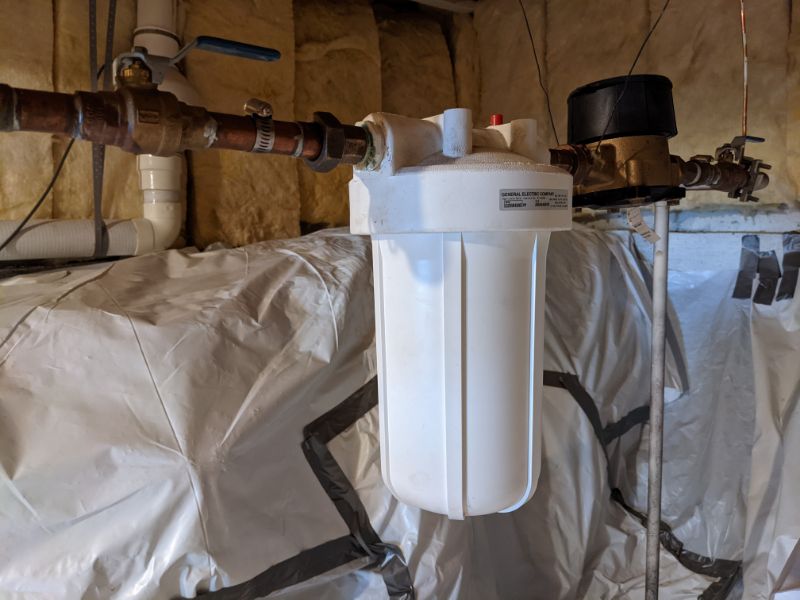
⚙️ How Does A Sediment Filter Work?
A sediment filter works by using a process known as mechanical filtration.
This process prevents large particles from passing through the filter media while allowing water molecules to flow through the filter pores.
Imagine a mechanical filter a bit like a colander, which lets water flow through the holes, but prevents the food you’re straining (i.e. pasta or vegetables) from escaping.
Different types of sediment filters have their own techniques for reducing particulates. Some filters have a very large surface area and can catch large volumes of debris, while others use depth filtration, with layers and layers of filter media that gradually decrease in pore size as the water reaches the filter’s center.
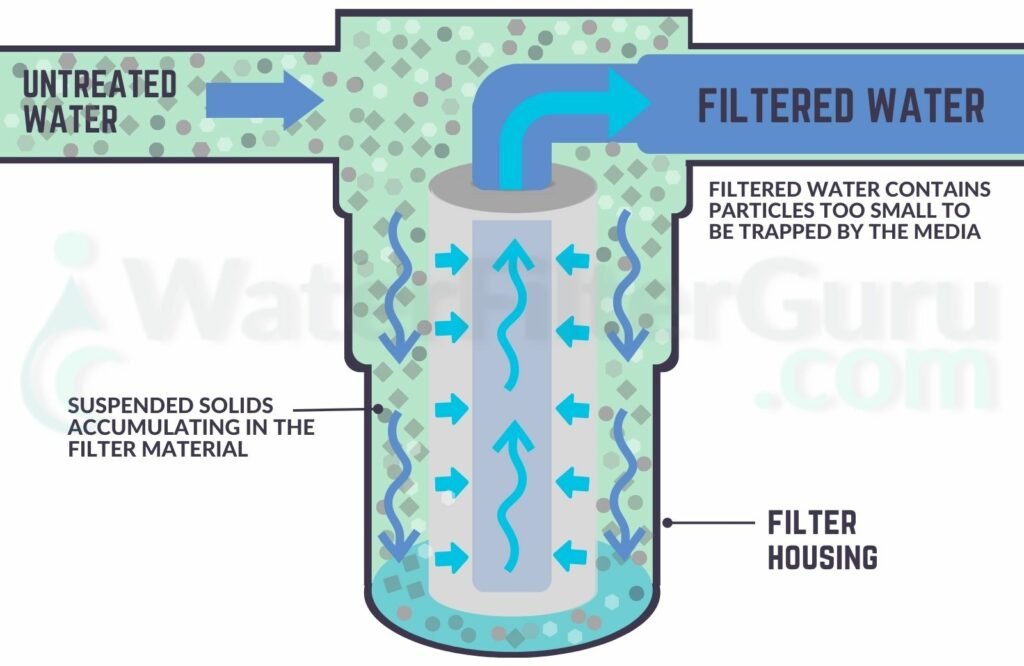
📥 Different Types of Sediment Filters
Here are the most common types of sediment filters:
Pleated Filters
Pleated filters, or surface filters, are accordion-shaped filters that use multiple filter media layers with a very large surface area. These filters trap sediment in their filter layers, and the trapped debris supports the mechanical filtering process and amplifies its efficiency. You can wash and reuse a pleated filter.
String-Wound Filters
String-wound filters are made from polypropylene string, cotton, or polyester, which (as the name suggests) is tightly wound around a core. The gradient density produced by the filter’s design makes it highly effective in trapping particulate matter, with an increasing fineness towards the filter’s center. The filter needs to be replaced when the strings begin to loosen due to a buildup of debris.
Spin-Down Filters
Spin-down filters are a common whole-house water filter solution for large visible debris and sediments. These filters spin water at high speeds, using centrifugal force to divert the solids into the outside of the housing, where it settles at the base of the chamber. Spin-down filters have a valve that flushes the sediment out of the housing, allowing them to be reused again and again.
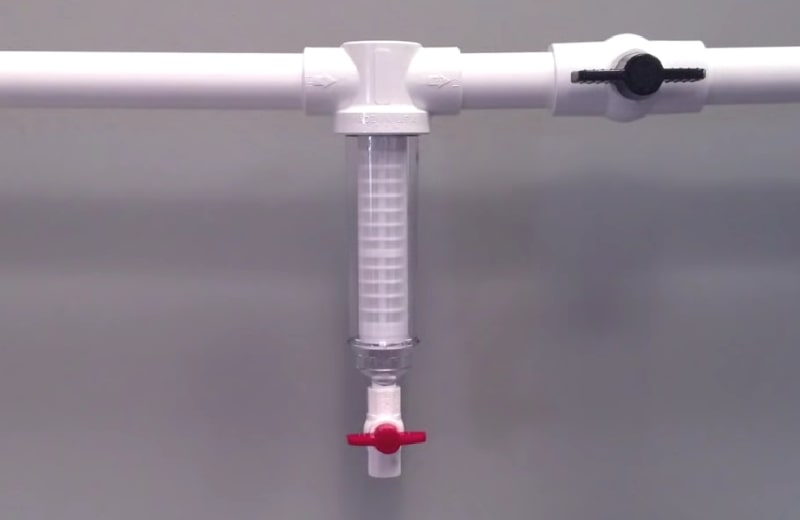
Bag Filters
Bag filters are a lesser-used filter type that send water through a bag, typically made from polypropylene or polyester felt. These filters can remove sediment as small as 1 micron or as large as 200 microns, depending on the filter material. They’re used in a range of applications, including RO prefiltration.
Melt-Blown Filters
Melt-blown filters are cylindrical cartridges made from layered fibers, produced by melt-blowing on a rotating spindle. These filters are depth filters, meaning that they filter sediment particles of smaller and smaller micron sizes as water flows toward the denser inner core of the filter. Sediments as small as 10 microns can be trapped in melt-blown filters.
🧫 What Does a Sediment Filter Remove?
A sediment water filter removes all particulate matter that can be seen by the naked eye, including:
- Sand
- Dirt
- Dust
- Rust
- Debris
- Gravel
- Turbidity
- Cloudiness
- Discoloration
💡 What can’t a sediment water filter remove? Don’t expect this filter to remove heavy metals, chemicals, microorganisms, or any other dissolved substances – these will simply slip through the filter’s pores.
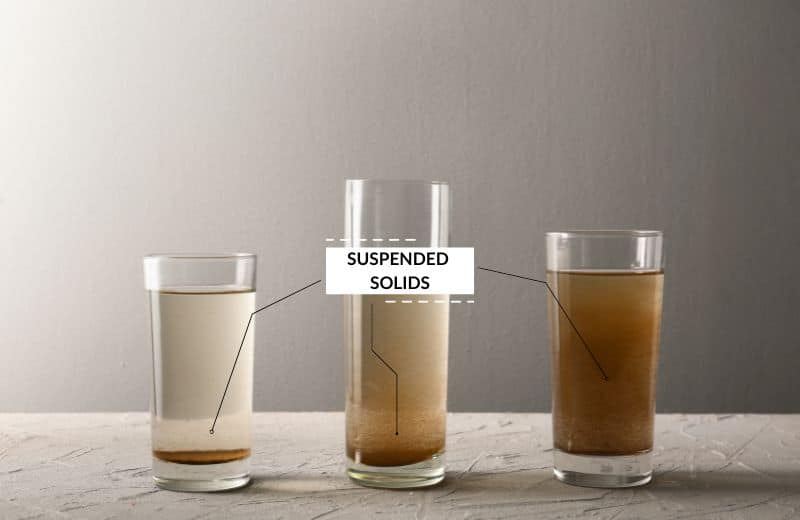
🔬 Sediment Filter Micron Size Range
The size of the pores in a sediment water filter is known as the filter’s micron rating. The smaller the filter microns, the greater the range of sediments the filter will trap.
Let’s say, for example, you buy a 10-micron filter. This will be able to remove all contaminants down to 10 microns in size. Any particles smaller than 10 microns will be small enough to fit through the filter pores.
The micron size for sediment filters ranges from 5 to 200 microns. The filter micron rating you need depends on the size of the particles you need to remove from your water.
The goal of sediment filtration is not to remove as many impurities as possible. If the micron size is too small, too many contaminants would be trapped in the media, causing it to become clogged at a faster rate and requiring more frequent filter replacements.
There are other filter media, such as carbon and KDF filters, that you can use downstream of a sediment cartridge to remove additional smaller contaminants. Sediment filters simply act as the first line of defense against the biggest particulates in your water.
Nominal vs Absolute Micron Ratings
There are two sediment water filter micron rating types: absolute and nominal.
A nominal rating means that the filter will remove 95% of particles of that micron rating, while an absolute rating guarantees 100% removal of all particles of that micron rating.
Absolute filters are a good choice if you want to eliminate a specific contaminant, but nominal filters are the most commonly used.
👨🔧 Continue Reading: Determining the Ideal Micron Filter Size for Well Water
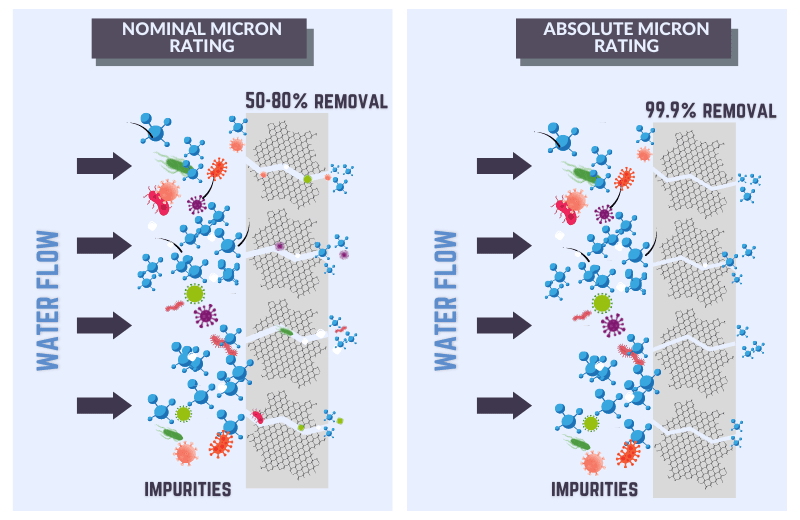
🚰 Where Are Sediment Filters Used?
There are a few different occasions in which a sediment water filter might be used:
Multi-Filter Systems
You’ll commonly find a sediment filter as the first filter stage in multi-stage water filtration systems.
For instance, a whole-house water filter system with carbon block or KDF filter cartridges may begin with a sediment filter.
Or, an under-sink or countertop reverse osmosis system may use a sediment filter as the first filter stage.
The sediment filter has two purposes here: to improve your water quality and prevent damage to your plumbing, and to protect the later filter stages from clogging.
Sediment particles are larger than most dissolved contaminants, so they block the pores of carbon block filters and reverse osmosis membranes. A sediment water filter removes the sediment before water flows through these filter stages, preventing them from becoming clogged and inefficient.
UV Purifiers
Sediment filters are also commonly used as a pre-filter to a UV water purification system.
A UV system kills microorganisms like bacteria and viruses by exposing them to UV light, which scrambles their DNA and makes them unable to replicate.
If your water is turbid or rich in sediment, it’ll reduce the effectiveness of a UV system because the sediment particles block the UV light from penetrating the microorganisms, which means that some harmful pathogens may be retained.
A sediment water filter removes sediment before the UV process, so that water is clear and the UV filter can target all microorganisms effectively.
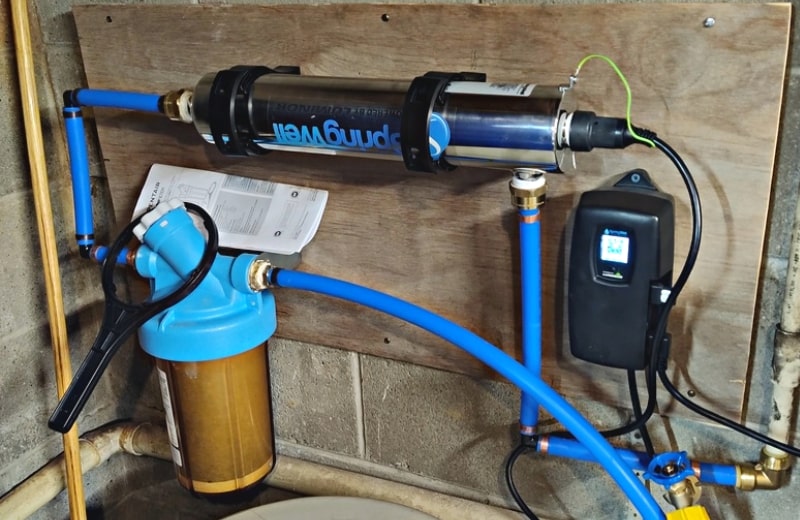
Water Softeners
Most water softener systems come with a sediment pre-filtration cartridge.
Sediment in a hard water supply could build up inside the water softener resin, reducing its softening capacity.
Sediment may also damage and clog the water softener components, including the delicate venturi valve.
A sediment pre-filter removes these large particles and prevents them from hindering the softening process, which, in turn, extends the lifespan of the resin and helps it to sustain optimal softening capacity.
Standalone Filters
Finally, you might install a whole house sediment filter as a standalone filter, without any other water treatment stages to follow.
If your water is sediment-rich but otherwise clean, a sediment water filter alone will do the job.
The filter will remove particles of various sizes (depending on the filter micron rating), protecting your plumbing, fixtures, and water-using appliances from abrasive damage or clogging as a result of sediment.
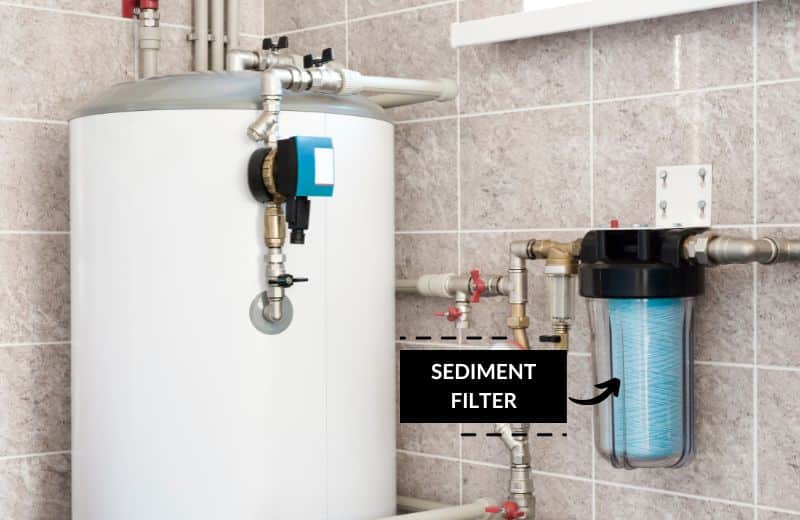
🆚 Whole House Sediment Filters vs Point Of Use Sediment Filters
So, when might you need a point of entry (whole house) sediment filter, and when might you need a point of use filter?
We recommend a whole house water filter if you want to reduce sediment as soon as water enters your home. This will protect your entire home’s plumbing system, including your hot and cold water pipes, from sediment damage.
We only recommend using a point of use filter if you have a POU water filtration system that needs to be protected against suspended solids. So, if you install a reverse osmosis system under your kitchen sink, you’ll need a sediment water filter to protect the RO membrane – regardless of whether or not you think your water contains suspended particles.
If your water contains a lot of sediment, especially if it’s visible, we always recommend a whole home filter system. It might be more expensive, but there’s no point in buying a point of use water filter that will only protect a very small percentage of your plumbing.
🤔 Who Needs a Sediment Filter?
You need a sediment filter if your water contains particles of dust, dirt, sand, rust, or any other debris.
You’re more likely to need a sediment filter if you have well water than if you have city water.
City water is treated prior to being delivered to your home, and the treatment process should make the water clean and sediment-free.
Well water, on the other hand, is treated by the well owner depending on the contaminants it contains. Water from wells is more likely to contain sediment because it hasn’t undergone treatment at a facility and the pump may draw sand and gravel particles from the aquifer along with the water.
Still not sure whether or not you need a sediment filter? Fill a glass with water from your faucet and leave it for a few minutes. If you can see floating sediment, your water looks murky, or sediment is beginning to settle at the bottom of the glass, you could benefit from a sediment filter to protect your plumbing.
You could also test your water with a laboratory test if you want to confirm how much sediment it contains, and the micron size range of the sediment detected. This will help you to choose the right type of sediment filter for your situation.
👨🔧 Check out our in-depth analysis: The top sediment filters for various applications
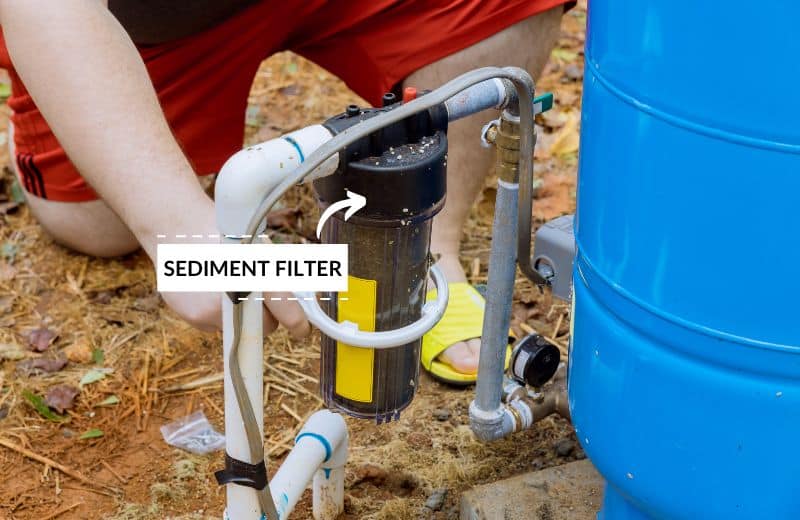
🔧 Sediment Filter Installation & Maintenance
When it comes to installation and maintenance, sediment filters don’t present too much hassle.
The installation process depends on the location of installation and the filter type. A standalone whole house water filter will present the most work because you’ll need to intercept your main water line to install the filter.
Check your user manual for the step-by-step install process for your sediment filter type.
Maintenance is straightforward, too. Regardless of install location, the average lifespan for a sediment water filter is 6-12 months.
Why do you need to replace a sediment water filter? Because it’ll eventually get clogged with sediment and will be unable to continue to filter your water effectively.
Spin-down filters have a longer filter life because they can be reused again and again, but you’ll still need to clean the filter (if it doesn’t have an automatic cleaning feature) and replace the filter screen every 6-12 months on average.
You’ll know it’s time to replace your filter because the flow rate will become much slower and you might notice that your once-clean water supply is starting to look cloudy or turbid once more.
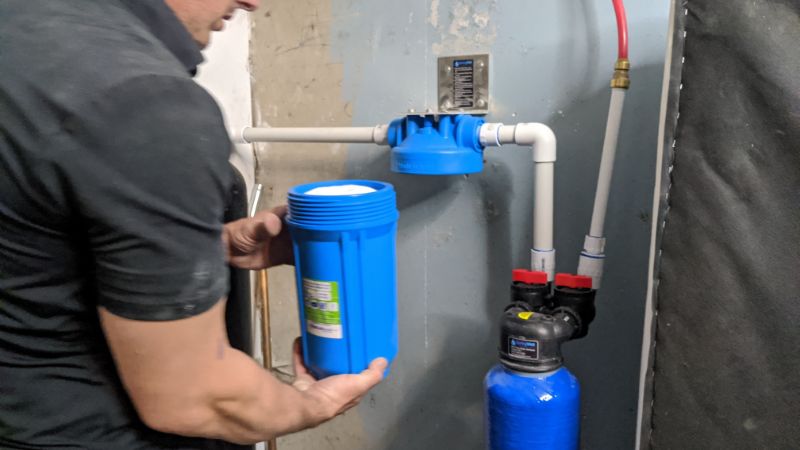
⚖️ Advantages and Disadvantages of Sediment Filters
Let’s finish off with a quick roundup of the advantages and disadvantages of sediment filters, based on what we now know.
Sediment Filter Pros
- Protect your plumbing system from damage caused by suspended solids in your water.
- Also prevent washing machines, faucets, shower heads, dishwashers, and other fixtures/appliances from the effects of suspended particles.
- Prevent damage or clogging to other filter cartridges in a multi-stage filter system.
- Cost-effective and affordable to maintain.
- Easy installation and maintenance.
Sediment Filter Cons
- May have small effects on water taste but can’t remove most poor tastes and odors.
- Don’t remove chemicals, heavy metals, or other dissolved contaminants in drinking water.
- Require routine maintenance/filter changes to continue to provide effective water treatment.
Related Readings:
🔚 Final Word
A sediment water filter is the most effective water treatment system for removing suspended particles from water.
If you have well water, you’ll particularly benefit from the protective properties of a sediment filtration cartridge.
Make sure you know your options before you start shopping – and check that a filter has plenty of positive customer feedback before spending your money.

I just installed a 25 micron whole house filter in my home. I decided to install one, against most plumbers objections, because I installed a new water softener which has a charcoal filter on the front end. No one suggested this filter for our domestic city water, but I had it installed anyway.
Now the real story: within two weeks the pure white filter has turned orangish to my surprise! I’m filtering domestic city water and I get this in two weeks? What have I been drinking over the previous years??
What are your thoughts please?
Not surprising. Old water distribution lines are disgusting. Orangish color indicates oxidized iron, perhaps rust from the distribution pipes